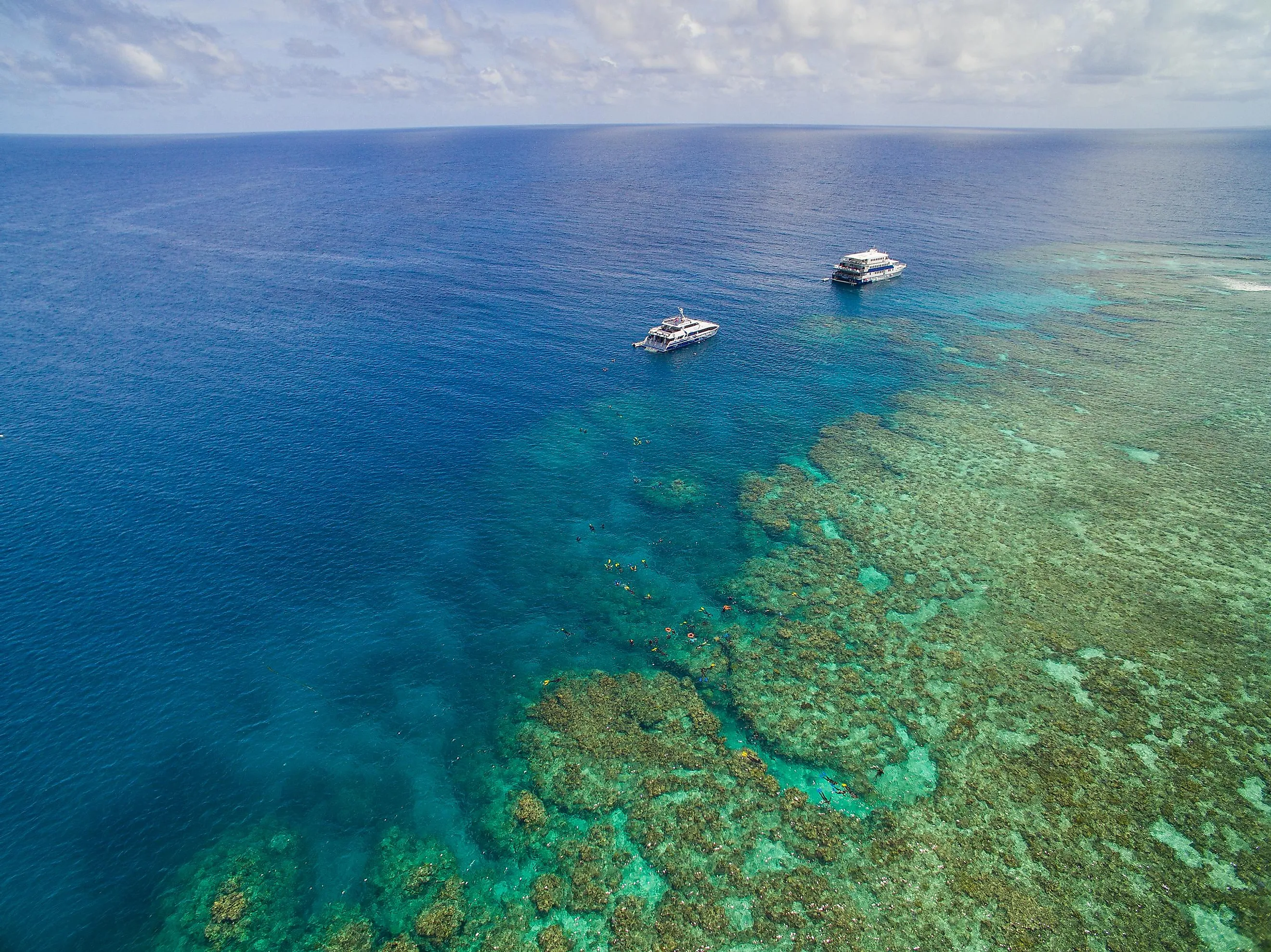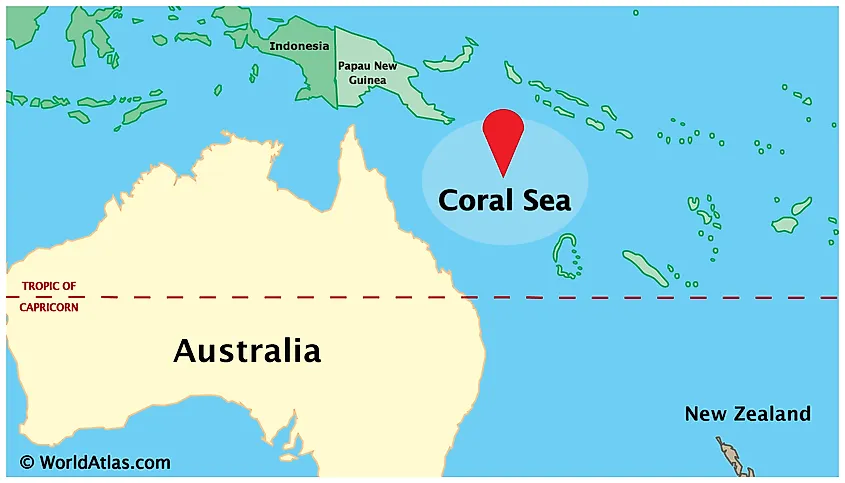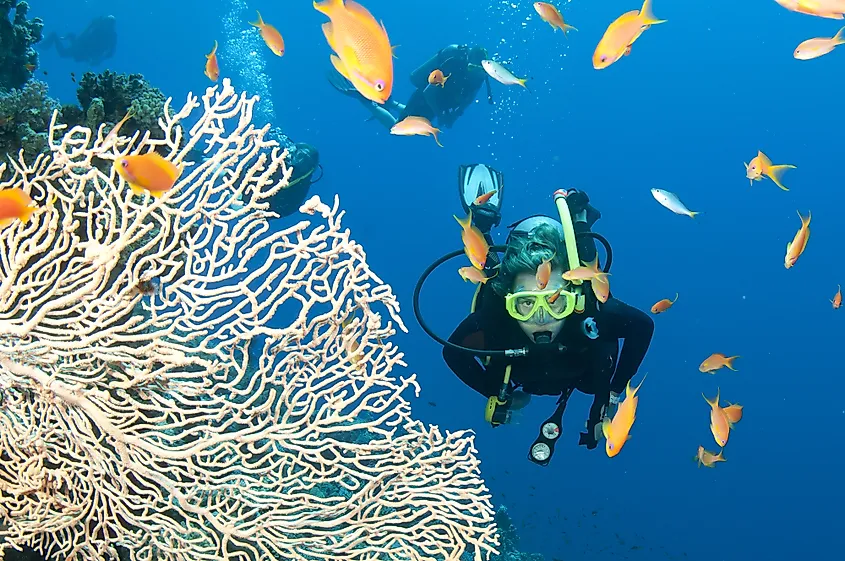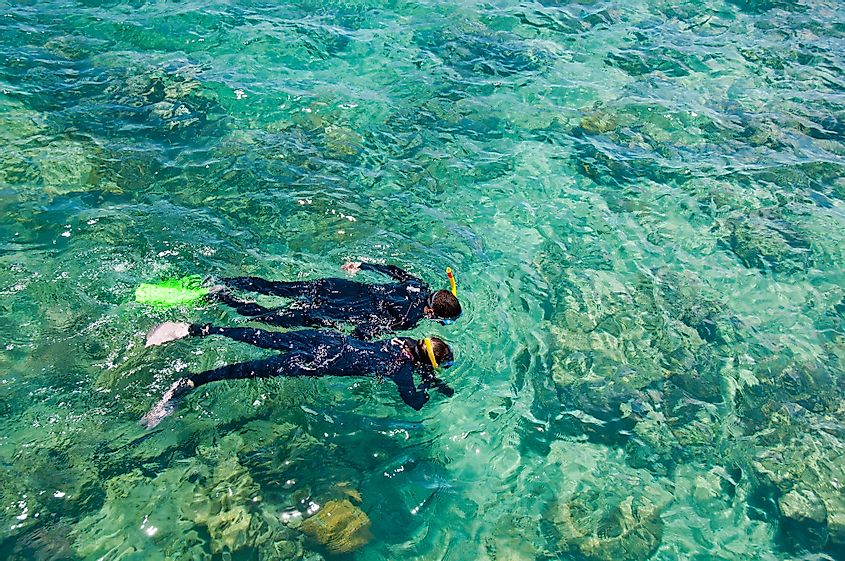
Coral Sea
Covering a vast area of 4,791,000 sq. km, the Coral Sea is a tropical marginal sea of the southwestern Pacific Ocean that is located off the northeastern coast of Australia. The sea contains many islands and reefs including the Great Barrier Reef which is considered the world’s largest coral reef system. The Coral Sea reaches a maximum depth of 9,140m and an average depth of 2,394m.
Geography Of The Coral Sea

The Coral Sea is bounded by the eastern coast of Queensland in the west; by the Republic of Vanuatu and French Overseas Collectivity of New Caledonia in the east; by the southern extremity of the Solomon Islands in the northeast; and by the southern coast of eastern New Guinea in the northwest. In the south, the Coral Sea merges with the Tasman Sea; in the north, it merges with the Solomon Sea; and in the east with the Pacific Ocean. In the northwest, the Coral Sea links with the Arafura Sea via the Torres Strait. The Coral Sea has been named after its numerous coral formations including the Great Barrier Reef, the Lihou Reef, and the Chesterfield Islands.

Geologists believe that the Coral Sea basin was formed between 58 and 48 million years ago due to the upliftment of the Queensland continental shelf. At the same time, the subsidence of the continental blocks also led to the formation of the Great Dividing Range. It is also believed that the Coral Sea has been a great source of coral for the Great Barrier Reef during the days of its formation and after the lowering of the sea level.
The Burdekin River is a major river that flows into the Coral Sea. The Coral Sea experiences a subtropical climate and faces tropical cyclones during January and April. The surface water temperature in the southern part of the sea varies from 19°C during August to 24°C in February. The temperature of the northern part of the sea remains more or less warm and stable throughout the year. Depending on the area, the annual rainfall varies between 1,000 and 3,000mm, which falls mostly between December and March. The Coral Sea is dominated by three major Coral Sea surface currents including the South Equatorial Current, the Hiri Current, and the East Australian Current. These currents form a counter-clockwise gyro and brings the warm nutrient-poor waters from the Coral Sea to the cool waters of the Tasman Sea.
Ecology Of The Coral Sea

Along with the Great Barrier Reef, the Coral Sea contains 49 different habitats that support more than 300 threatened species. The islands of the Great Barrier Reef contain over 2,195 known floral species of which 3 species are endemic to the region. The plant species are either woody or herbaceous, with the woody ones situated in the northern islands and the herbaceous ones in the southern islands. The Coral Sea contains several species of sponges, prawns, crabs, gastropods, anemones, and lobsters; about 52 species of deepwater sharks and rays; 30 species of whales, porpoises, and dolphins; and the spawning aggregations of black marlin and deep-sea lanternfish which in turn attracts schools of tuna, whale sharks and billfish. In addition to this, there are abundant soft corals, cold-water corals, and 18 spectacular coral reef systems. The Coral Sea habitats are critical to the populations of endangered sea turtles, 17 species of sea snakes, more than 1,500 fish species, and over 200 species of seabirds that are dependent on it.
Brief History
It is believed that the coastal areas of the Coral Sea were inhabited about 40,000 years ago by the ancient Aboriginal people who descended via the Northern Islands. The sea served as the site of the Battle of the Coral Sea - a major naval battle between the Allied forces of the United States and Australia and the Imperial Japanese Navy in May 1942, during the Second World War. The ultimate victory of the Allied Forces in the battle prevented the Japanese forces to invade and occupy Port Moresby. Through many years, the Coral Sea has played an important role in navigation and so far, 10 major ports have alone been established on the coast of Queensland. It has been recorded that as of 2007, over 3,500 ships operated in this region and had made over 9,700 voyages transporting various economically important materials throughout the world.
Tourism Activities In The Coral Sea

The Great Barrier Reef serves as a tourist and fishing hotspot and it is believed that more than 14.6 million people have visited the Coral Sea region to witness this great natural wonder. The growing environmental concerns led to the establishment of the Great Barrier Reef Marine Park in 1975 and the Great Barrier Reef was designated as a UNESCO World Heritage Site in 1981. On April 3, 2010, a Chinese ship carrying about 950 tonnes of oil ran aground to the east of the Australian city of Rockhampton, resulting in the Great Barrier Reef oil spill. This massive oil spill caused a lot of damage to the Coral Sea as well as the Great Barrier Reef. In 2017, the Coral Sea Marine Park covering an area of 989,836 sq. km was established. The Coral Sea Marine Park is considered one the largest protected areas in the world and the single largest marine park in Australia. However, in recent years, both the Coral Sea and the Great Barrier Reef have been subjected to many environmental threats including the rise in global temperatures, climate change, outbreaks of crown-of-thorns starfish, coral bleaching, ocean pollution, and large-scale exploitation of oil and natural gas.










